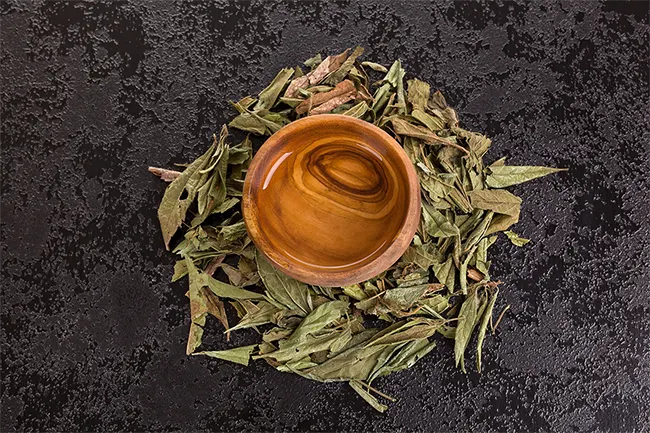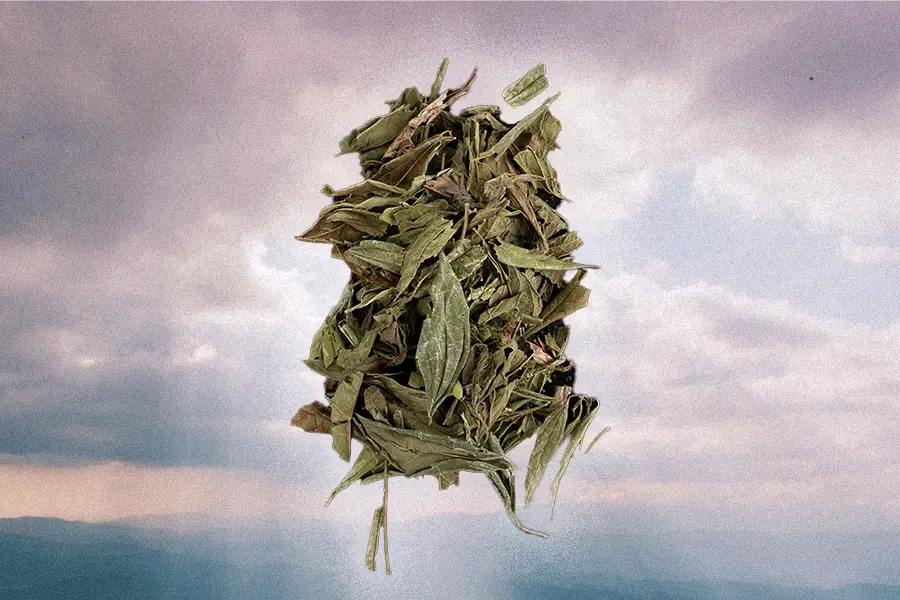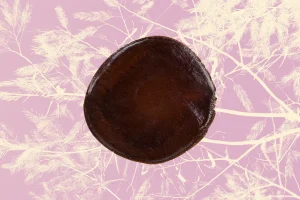Commonly known as zacatechichi in Mexican markets, the leaves and flowers of the Calea zacatechichi plant are now becoming a common herb in online shops. While psychonauts online use the leaves to attempt to induce lucid dreams, in Mexico, the plant remains part of traditional medicine for curanderos, treating everything from hangovers to diabetes.
“I read for the first time about the use of zacatechichi as a plant used to induce sleep by the Chontal communities of Mexico,” says Darely Acosta, a Mexican ethnobotanist. Acosta has a longstanding interest in entheogens and ethnobotany, but interest in zacatechichi came “because of the issues that communities in the southern region of Morelos were facing, such as habitat loss and overharvesting for personal use and sale.”
What is Calea Zacatechichi (Mexican Dream Herb, Bitter Grass)?
Chontol or Chontales communities in the Sierra Madre del Sur mountains of Southwestern Mexico steward Zacatechichi traditions and are credited with the practice of using the plant for divination in dream states. The Chontol term for the plant is thel-pelakano meaning “Leaf of the God.”Curanderos prepare tea with a handful of dried leaves before sleep, often followed by a cigarette, to occasion vivid dreams.
In truth, we don’t know how far zacatechichi’s use goes back, and the use of the plant is widespread in Mexico, well beyond the Chontol territory. Various local names and medicinal uses scattered across Mexico, which Acosta points out can vary even with a small region. We do know zacatechichi officially registered in the botanical world in 1820 as Calea ternifolia, but was later named again as Calea zacatechichi in 1835, incorporating the Nahuatl word zacatechichi meaning “bitter grass.”
READ: Opinion: Why the “Psychedelic Renaissance” is just Colonialism by Another Name

The plant grows in temperate forests of oaks and pine, high in Mexico’s cloud forests and lush tropical environment. Zacatechichi is known in the Northeastern state of Nuevo Leon, with its range extending south as far as Costa Rica. Thin branches form a bush covered in small oval leaves with serrated edges. Year-round, the plant will produce clumps of cream-colored or yellow flowers. The shrub stands around five feet high, although can be double the size in the right conditions. Fresh leaves are a vibrant green with somewhat violet undersides. And when the light is right, zacatechichi is said to appear luminescent, popping out from its surroundings.
Traditional Uses of Mexican Dream Herb
Lilian Mayagoitia-Novales, a researcher with the National Institute of Psychiatry in Mexico, began her career studying the impacts of zachetechichi. She tells DoubleBlind about sitting with a curandero early in her research—she’s been a scientist for almost forty years. “He informed me that the plant he used had to be collected at a particular time of year and that the place where it grew had adequate conditions to obtain good quality for its use. He offered us an infusion of Calea zacatechichi, and we drank it while he told us that during his sleep, he ‘received visitors’ who could inform him about the concerns of the patient who consulted him,” she says.
How to Grow Shrooms Bundle
Take Both of Our Courses and Save $90!
“The next day, he asked me how I had slept. My dream was with many awakenings and vivid dreams, but since during the talk I had not meditated on a particular topic to be resolved during the dream, none of the content was of great impact; however, the increase in the remembered dreams was clear.”
Calea zacatechichi for Lucid Dreaming
Many now know zachetechichi as Mexican Dream Herb, which is marketed as a lucid dreaming aid. Counted as a oneirogon, which in Greek means “dream create,” the plant is now pretty common in online herb bazaars for those wanting to explore the Western dreamworld.
Reviews of the herb are mixed. Some people approach lucidity, while others feel very little. Others report success when taking the herb over a longer period or using it in combination with other herbs or supplements. Overall lucidity seems rare, although a common thread of remembering dreams and often sustained, tranquil well-being in the days afterward prevails.
READ: The Trippy Truth About Amanita muscaria, The World’s Most Famous Mushroom

“For oneirogens, set and setting parameters seem more important than for hallucinogens, I think they have a more specific and subtle influence,” says Guanluca Toro, an environmental chemist and author of Drugs of the Dreaming. “I’ve experimented with the plant, before bed, and during a REM phase, noticing a slight (not so dramatic) increase in the oneiric activity, but perhaps I was under the power of suggestion.”
“It is possible that the action of oneirogens is the result of a cultural predisposition, programming, or social convention,” says Toro. “For example, their action could be ‘activated’ by a ritual, even if the plants don’t have pharmacological properties.”
Following fragments of the traditional, many oreironaughts smoke the herb for a mild cannabis-like effect while consuming the tea. Also popular is putting zacatechichi into capsules because of the unpleasant bitter taste, which can be nauseating, to the point of vomiting for some. The smoke, too, isn’t noted as smooth. Also of note are also suspicions of allergic reactions, in a small number of people and reports of sleep paralysis.
For Chotol curanderos, according to The Atlas of Indigenous Peoples of Mexico, causes for the illness are more than physical, such as “mal de vergüenza” a shame illness, “el empacho” a blockage, or even “el mal de ojo” the evil eye. Diagnosis might involve burning copal, a fragrant tree resin, and offering an egg to invoke spirits and perform divination, with wide applications beyond illness, like learning the origin of a lost object or person and perhaps even obtaining messages of the future.
Mexican Dreaming Herb Effects
“It is perhaps the most bitter substance known to man, in fact, that might be applicable beyond this solar system. It’s bad man!” says Paul from Herbal Dimensions, a UK-based online herbal dispensary. After I emailed about zacatechichi, an inspired Paul took a full gram in capsule form.

“I could feel a heaviness in my awareness, and within thirty minutes had climbed into bed. I was quite wakeful during the night and found myself going through one set of fleeting dream images to another. I do not usually experience a great deal on the dream front. I was up four times during the night. This is more than usual, and part of the effect of the Calea for sure.”
Indeed, Mayagoitia’s 1986 studies documented this exact effect. After consuming zacatechichi in a controlled nap, Mayagoitia found zacatechichi can increase the amount of spontaneous awakenings. Study participants were able to recall a higher amount of intense dreams in comparison to a placebo or conventional sleep aid, diazepam. With the aid of EEG to measure participants’ brainwaves, Mayagoitia showed superficial stages of sleep were improved, instead of the deep slow wave sleep and REM sleep stages. It did seem, however, that during the earlier stages of sleep, there was an increase in hypnagogic imagery.
Paul confirms this while detailing his zacatechichi-induced dream about fly fishing and watching his line break the surface tension of water in slow motion to pull out silvery fish and then lower them back in. But it is tricky to nail down exactly how zacatechichi works, with a long list of potential bioactive chemicals in the plant.
“In our 2020 study, we have detected 41 compounds in the aqueous extract of Calea zactechichi that belong to the chemical groups of polyphenols, sesquiterpene lactones, flavonoids and flavonoid glycosides,” says Mayagoitia, referring to work done alongside Lucía Martinez-Mota, suggesting zacatechichi could have effects on anxiety on depression, backing up anecdotes of a pleasant and persisting mood after using zacatechichi.
“It’s not simple to say if a truly oneirogenic compound is present in the plant, I can hypothesize sesquiterpene lactones, which are also found in species of lettuce considered psychoactive,” says Toro. There are 37 sesquiterpene lactones in zacatechichi. “Their effects in Calea zacatechichi could be modulated by other compounds.”
Mayagoitia also cautions one study “reported liver and kidney toxicity, but they worked with very high doses, and the plant was acquired commercially,” adding that “[zachtechichi] use is not daily and is accompanied by the interpretation of a person who, sharing with the patient his idiosyncrasy and cosmogony, can provide the actions that will lead him to resolve his concerns, anxieties and the sufferings that these worries can generate.”
A Caution About Overharvesting
Throughout Mexico, zachtechichi is used for an incredible amount of medicinal applications. A review of C. Ternifolia details many of its uses, like stimulating appetite or treating problems of the liver, and a growing interest in using the plant for a treatment for diabetes.
“I have used it primarily for deworming and as an infusion after a fright, shock, or anger,” says Acosta and explains how in traditional Mexican medicine, plants with bitter flavours are used to treat bile-related issues caused by such emotional disturbances. Yet despite the long relationship between curanderos around Mexico and zacatechichi, Acosta’s PhD research in Morelos reveals a changing environment she fears threatens the plant. “Unregulated extraction, livestock farming, and the lack of interest among new generations in preserving and learning about the uses of this and other plants are other contributing factors.”
The plant is considered able to handle human disturbances but might not be keeping pace with the demand in local Mexican markets, where it also is sold as “prodigiosa.” Acosta’s research is specific to Morelos, and what impact the online market might be having on Mexico is unknown, because nobody seems to know where all the zacatechichi is sourced from. The shrub can be cultivated outside of Mexico, too, as Ott published in Pharmacotheon. Apparently, the shrub is easily grown from cuttings and, once established, is low maintenance.

“I have run various ethnobotanical shops/businesses in the last 15 years and have never had trouble sourcing Calea, ever,” relates Paul. “I do not know exactly what region in Mexico my Calea comes from as this current material did not come directly. I will, though, endeavour to find out. Ensuring no ecosystem harm is coming from over-harvesting is important to me.”
How to Grow Shrooms Bundle
Take Both of Our Courses and Save $90!
For the moment, supply seems stable, at least to those of us cruising the online herb market, although several other online shops declined to comment on their sources for the dream herb. For Acosta, more research and perhaps even regulation could be a solution in Mexico.
“Ethnobotanical studies of the ecological impact humans have on plant populations and communities are scarce and necessary for making decisions regarding the conservation of zacatechichi and other medicinal resources,” says Acosta. She adds that because of the cultural, economic, and ecological importance of zacatechichi, management be well received and hopes for the development of integrative projects to work towards the conservation of the species at the population, community, and landscape level.
Frequently Asked Questions
Is Calea zacatechichi Psychoactive?
Yes, Mexican Dream Herb (Calea zacatechichi) is psychoactive. The plant is considered hallucinogenic, and it is traditionally used as medicine and before sleep to enhance dreams. Many chemical compounds in the plant may contribute to the herb’s psychoactive effects, but analysis reveals that the C. zacatechichi essential oil contains compounds called sesquiterpene lactones, specifically camphor, curcumene, spathulenol, caryophyllene oxide, b-eudesmol, and caleochromene A. Herbalist Lian Bruno has the scoop on herbs that pair with classic psychedelics.
Is Dream Herb Legal in the United States?
Calea zacatechichi is legal in the United States, with the exception of Louisiana. It’s also legal in most countries around the world—but always check the laws in your region before partaking in psychoactive substances. The plant is outlawed in Poland. Learn more about legal psychoactive plants in our full article here.
How Much is a Dose of Dream Herb?
At the time of writing, there are no definitive dosing guidelines for Mexican Dream Herb. Individual brands may list specific dosing guidelines for their products. It’s not uncommon for enthusiasts to brew pots of C. zacatechichi tea with up to three grams of dried leaves or more. But, high doses can bring nausea and other uncomfortable side effects. No specific safe dosage range is confirmed. Lucid dreaming is an ancient spiritual practice. We cover lucid dreaming and how to go about it in our full article here.

DoubleBlind is a trusted resource for news, evidence-based education, and reporting on psychedelics. We work with leading medical professionals, scientific researchers, journalists, mycologists, indigenous stewards, and cultural pioneers. Read about our editorial policy and fact-checking process here.

DoubleBlind Magazine does not encourage or condone any illegal activities, including but not limited to the use of illegal substances. We do not provide mental health, clinical, or medical services. We are not a substitute for medical, psychological, or psychiatric diagnosis, treatment, or advice. If you are in a crisis or if you or any other person may be in danger or experiencing a mental health emergency, immediately call 911 or your local emergency resources. If you are considering suicide, please call 988 to connect with the National Suicide Prevention Lifeline.



